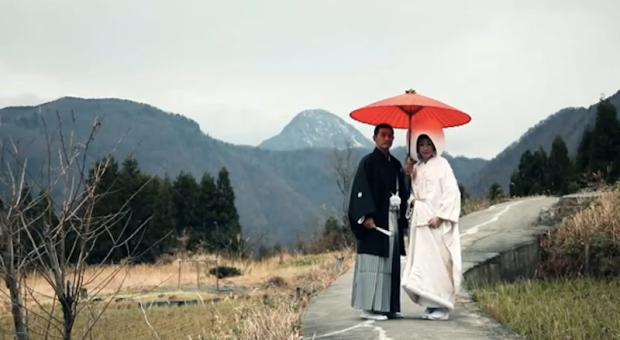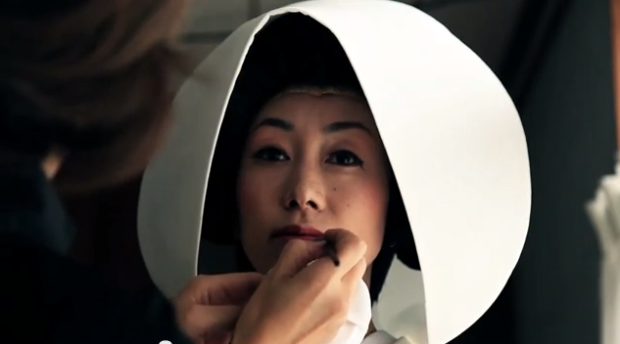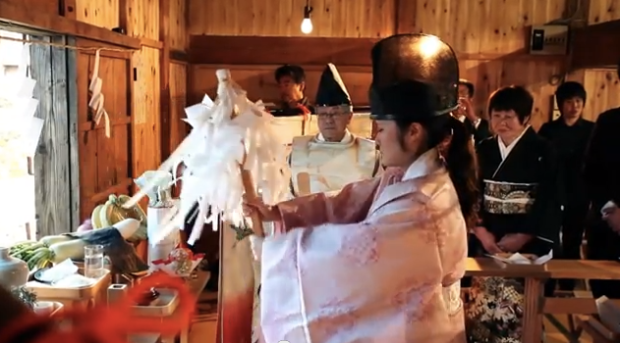Traditional Japanese Wedding Ceremonies
This is a beautiful story. It is very rare these days for a Japanese couple to get married in a traditional Japanese ceremony. Many opt for the Western ceremony which I find really sad because after looking at this video, the symbolism and intimacy of this ceremony is just beautiful.
Otari is a small village in the Nagano prefecture, central Japan, where 70% of the 3221 people who live there (as of October 2010) are over 65. This is because the majority of the younger generation move to the larger cities in search of employment and usually do not return to live in their home towns.
Although I have never been, the geography of this little town seems breathtaking. The Hime river (hime means Princess in Japanese) which originates in Hakuba (directly south of Otari) flows through the town to the Japan Sea with mountains of 1600 – 2800 metres above sea level on either side. The mountains on the west side of the river are considered the Swiss Alps of Japan.
Kenichi and Ayaka, a couple who have been married for 4 years already, moved to this town last year because they fell in love with the scenery and sense of community this town held. So they decided to hold a traditional Japanese wedding ceremony in the town on November 23 2012, which happened to be the first one in 42 years.
Happy Dayz Production uploaded a video of the wedding on YouTube which you can see below!
I also thought this would be a good opportunity to go through some of the main traditions and symbols behind a Shinto wedding. Many of these elements are actually rooted to ancient Japanese traditions where the bride had a more passive role than the groom.
Bridal Headdress
There are two types of bridal headdress’ that can be worn: tsuno-kakushi and wataboshi. The bride in this video is wearing the latter style. The literal translation of tsuno-kakushi is ‘a cover for horns’ which is said to hide the bride’s ‘horns of jealousy’. These headdress’ date back to 14th century Muromachi period where upper-class women used to cover their heads when outside the home. The bride is also wearing a wig and heavy white make-up which again plays a role in covering her features from public view.
Harai-gushi
The strips of white paper attached to stick that the priest waves around three times in the ceremony is called the harai-gushi and is a form of purification for the room and the participants. The actual Shinto ceremony is attended by close family of the bride and groom with the reception being held after.
Sake Drinking (San-san-kudo)
During the ceremony, the groom is seen to drink something from a small cup – this is actually sake! The sake is used to ‘seal’ the marriage. I’m not sure if they just didn’t show it here or they did a different variation of the sake drinking but the Shinto ceremony consists of a san-san-kudo (literally three, three, nine times) where three cups of differing size (small to large) are exchanged and drunk by the bride and groom as a form of wedding vow. This represents the newly formed bond between the couple they enter their new status of husband and wife. The groom in this video does seem to lift up his cup three times and slowly and gracefully drinks the sake on the third lift. I know it might be hard to comprehend how you would drink sake gracefully (for me, sake is WAY too strong), but the drink also signifies that there may be hardships that will have to be overcome in the marriage and by undertaking the san-san0kudo ceremony, the spirits will help you get through them.
Sake drinking actually dates back to the samurai period where common people used to drink sake in a Shinto ritual to form a bond with the deities. This was always done in a group where it is thought that this sharing of sake ritual united people and created a bond of friendship between them with God as the helper. Why three times? Three is considered a lucky number in Buddhism and nine means triple happiness.
Clapping Twice
After the san-san-kudo, everyone stands and claps twice. This is similar to when you clap twice in a Shinto shrine before you make a prayer which is said to bring the attention of the deities and ward off any evil spirits.
Reception
The reception is where the newlyweds are introduced as husband and wife to their other family, friends and colleagues. There are speeches made and a lot of sake drinking. TIP: If you ever are asked to make a speech, make sure you do not utter the words kireru (to be cut or broken), hanareru or wakareru (both mean to separate) as these words imply divorce!
References: YouTube , Ohito Times, Otari Population, ‘Modern Japan Through its Weddings’ by Walter Edwards




Stunning.
This is an excellent and interesting post, and what a beautiful video (I wish I could understand what the groom was saying/reading at the end). Thanks for sharing!
Hey! Sorry for the late reply and thanks for stopping by my blog 🙂 In his speech, he says something like ‘even if we get wrinkles or our backs curve, lets work together…’ So sweet!
very interesting post and blog. wish to read more from your end 🙂
Hi! Thanks for looking through my posts 🙂 are you interested in something particular about Japan? If you are I will try to make a post on it 🙂
please do write something on anime! I am a big fan of Bleach and Shinchan 🙂
If you love anime, I wrote a post on Mamoru Hosoda, the director of the Wolf Children movie. Have a look – it might be interesting for you 🙂 and in the mean time, I will see what I can do with Bleach and Shinchan ^^
hey thanks so much!! 🙂 Arigato is the word right? Am also interested in learning some Japanese 😉
What a great ceremony. I wish all the best for you and thanks for putting up this post.
michigan wedding minister
Thank you that’s very kind of you! Wish you all the best too 🙂
we all have someone to keep in our life and to have loose for to keep it on right track. I wish good lucks and dreams for those who have found their loved ones.
This is incredibly beautiful, but I am BEGGING you to take out the cheesy lounge music, at least during the ceremony, so that we can hear the real sounds of a traditional wedding. Thank you.
Hi LM! I wish I could help you with this but I didn’t actually make the video. It’s from YouTube 🙂